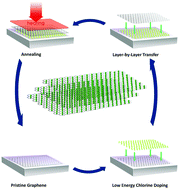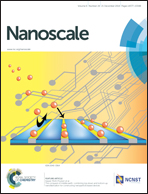Cyclic chlorine trap-doping for transparent, conductive, thermally stable and damage-free graphene†
Abstract
We propose a novel doping method of graphene using the cyclic trap-doping method with low energy chlorine adsorption. Low energy chlorine adsorption for graphene chlorination avoided defect (D-band) formation during the doping by maintaining the π-bonding of the graphene, which affects conductivity. In addition, by trapping chlorine dopants between the graphene layers, the sheet resistance could be decreased by ∼88% under optimized conditions. Among the reported doping methods, including chemical, plasma, and photochemical methods, the proposed doping method is believed to be the most promising for producing graphene with extremely high transmittance, low sheet resistance, high thermal stability, and high flexibility for use in various flexible electronic devices. The results of Raman spectroscopy and sheet resistance showed that this method is also non-destructive and controllable. The sheet resistance of the doped tri-layer graphene was 70 Ω per sq. at transmittance of 94%, and which was maintained for more than 100 h in a vacuum at 230 °C. Moreover, the defect intensity of graphene was not increased during the cyclic trap-doping.


 Please wait while we load your content...
Please wait while we load your content...